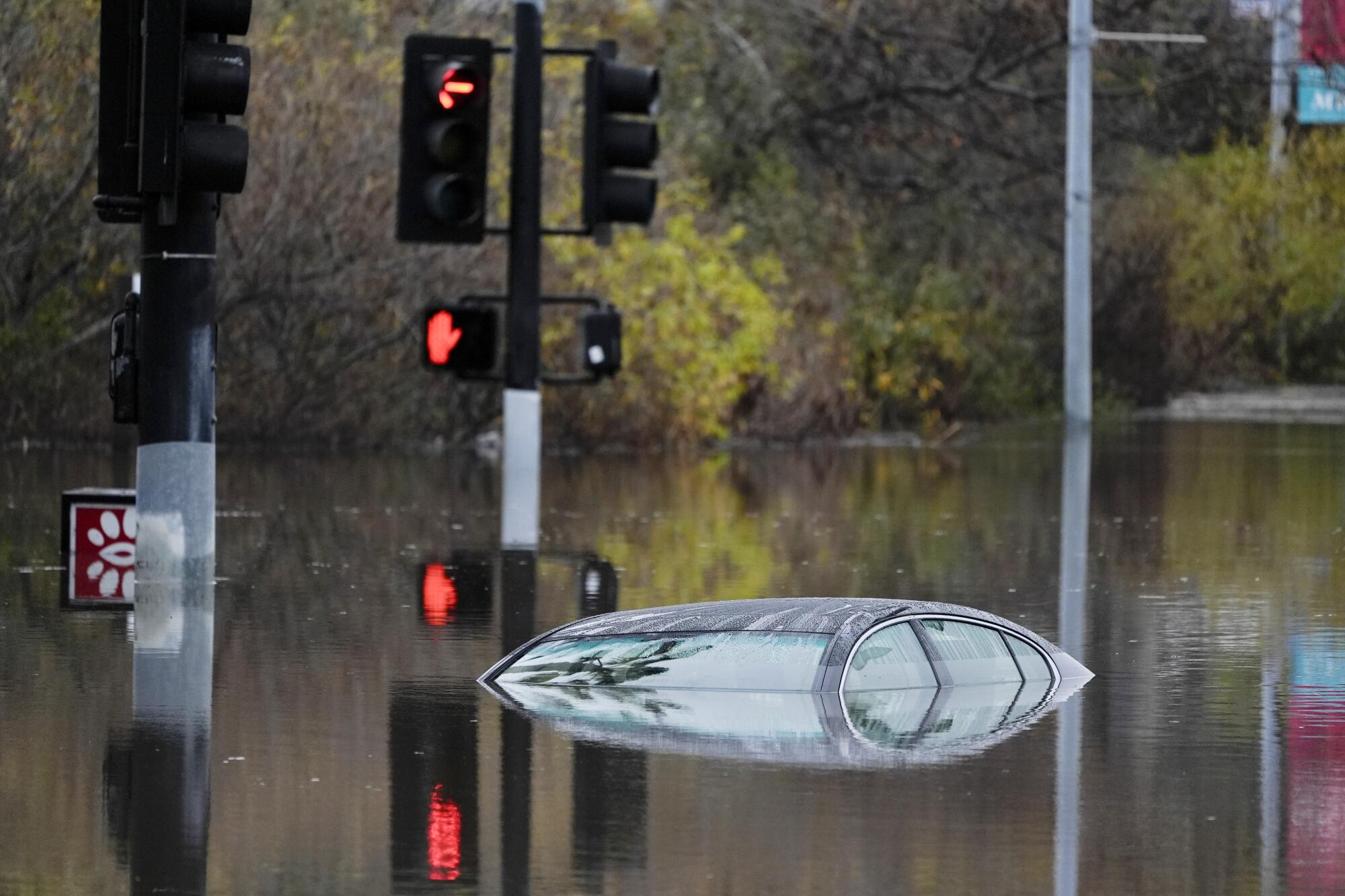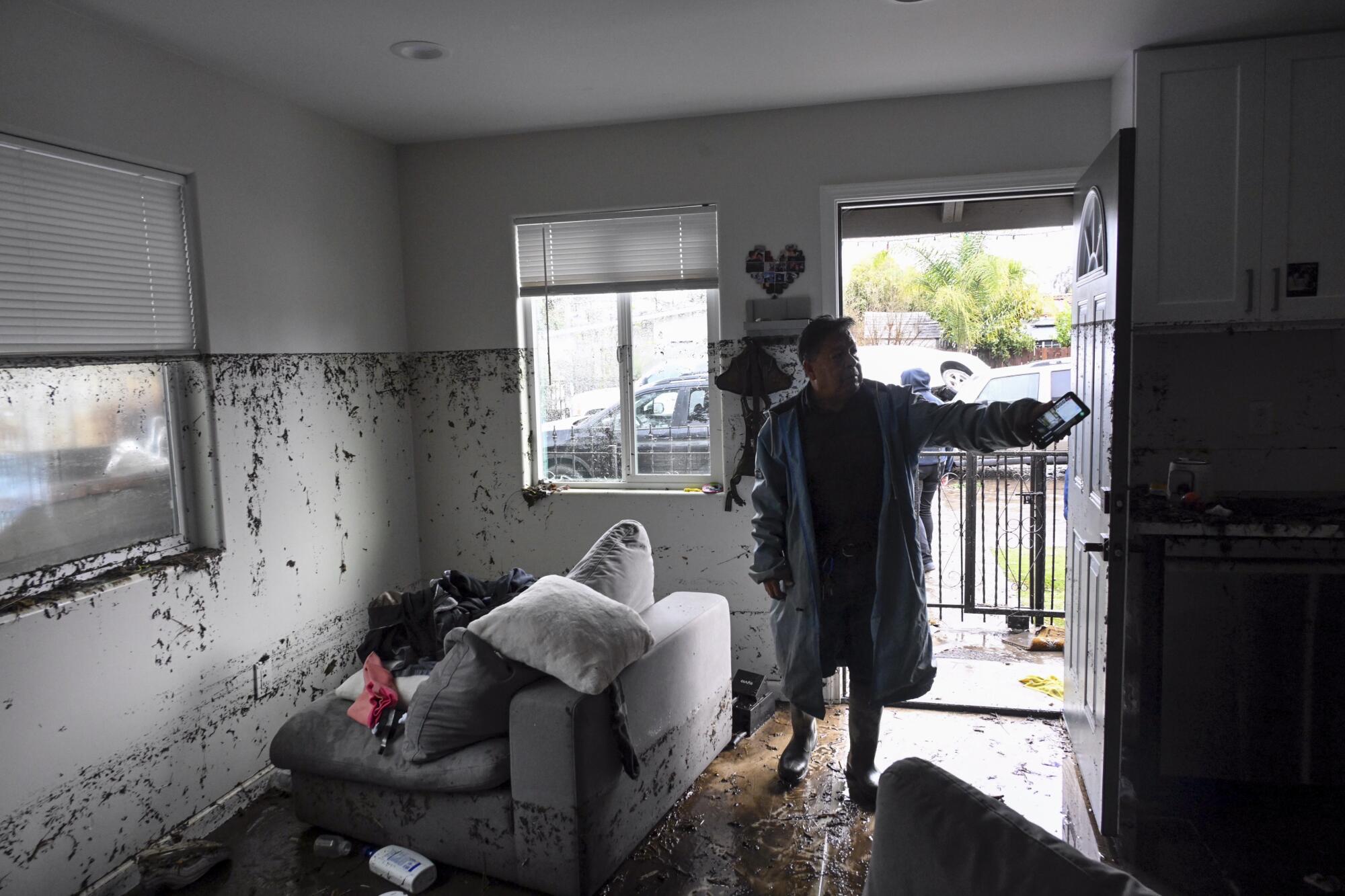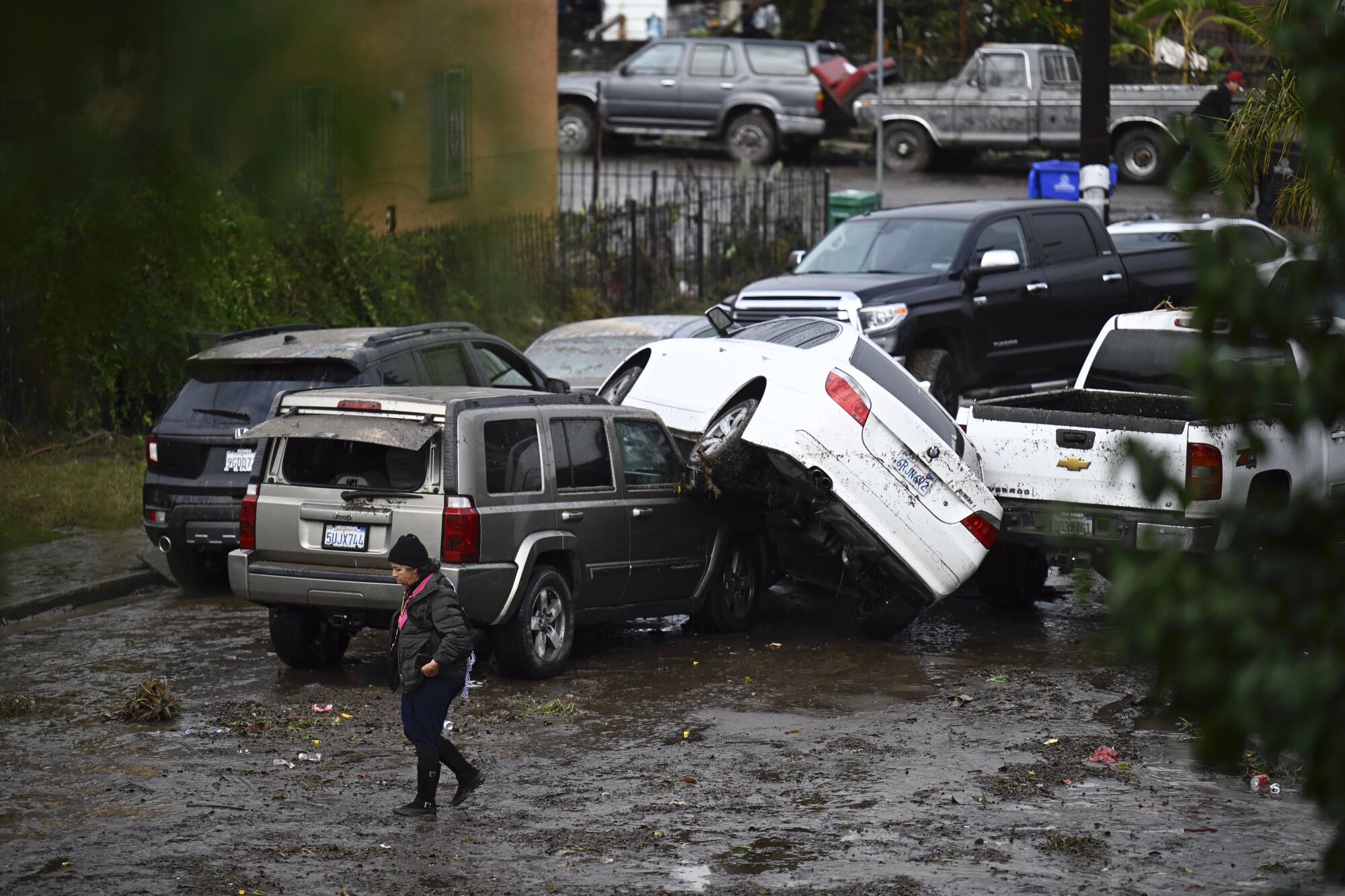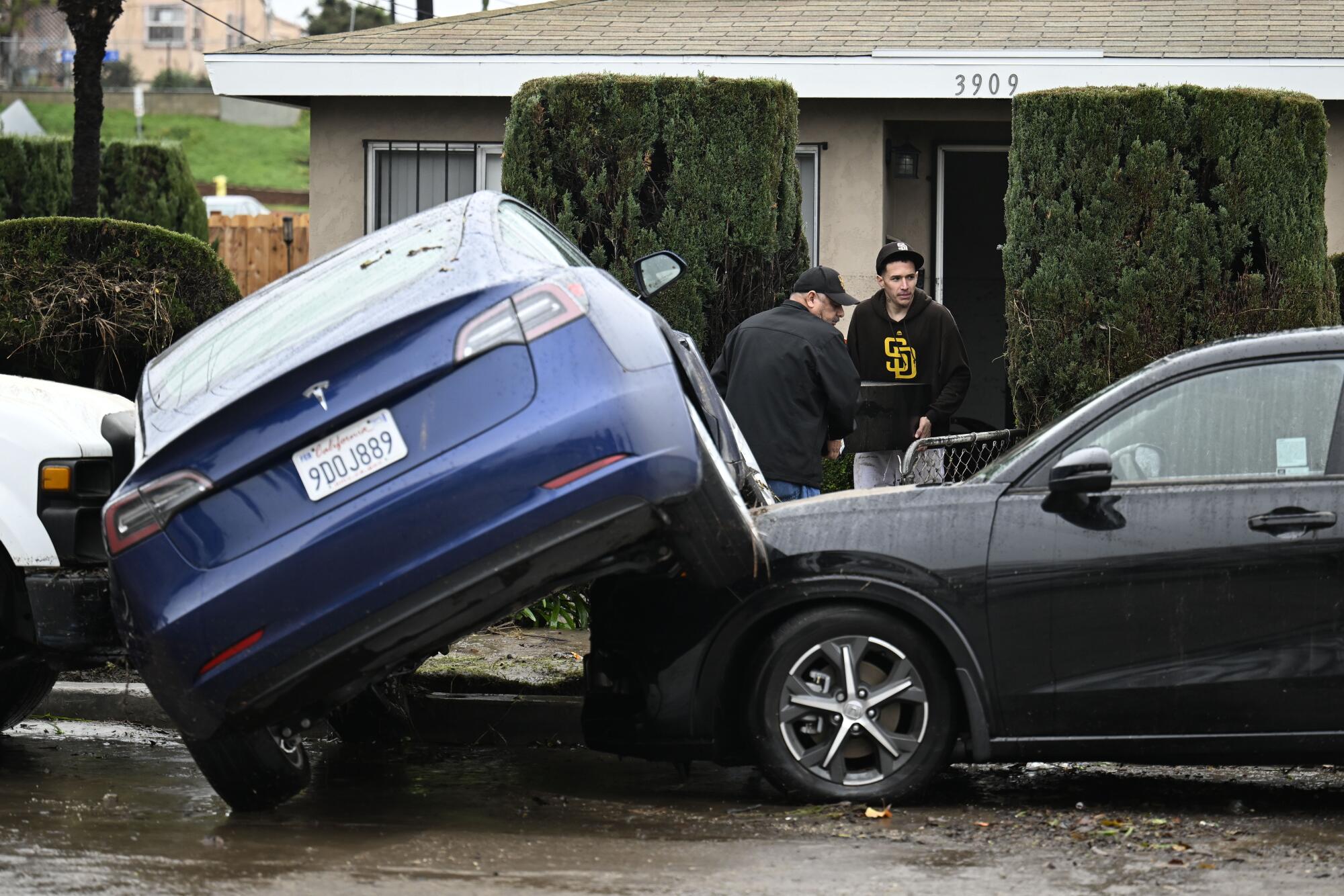
- Share via
Hundreds of people had to be rescued Monday as historic rain hit San Diego, causing significant flooding that closed major roadways, shut down bus lines, cut power and sent scores of residents scrambling for higher ground.
San Diego Mayor Todd Gloria declared a state of emergency Monday afternoon and urged residents to avoid flooded areas and unnecessary travel. Gloria said the city had activated its Emergency Operation Center, and the American Red Cross opened an evacuation center at Lincoln High School.
Nearly 4 inches of rain fell in less than three hours in some areas of San Diego — almost double the region’s average rainfall for the month — inundating the city and setting a record for the area’s wettest January day, said Casey Oswant, a National Weather Service meteorologist in San Diego. Previously, Jan. 31, 1979, was San Diego’s wettest day, when 2.57 inches fell at the airport, but early counts set Monday’s total well over that measure, Oswant said. Preliminary rainfall amounts placed Monday as San Diego’s fifth wettest on record, for any time of year.
“We had some really torrential rain this morning,” the meterologist said, noting that rainfall totals hit well over 2 inches in much of the metro area. The rainfall also slammed Tijuana, creating similar flooding issues, both in neighborhoods and along roadways.

The wet system first hit the Los Angeles area early Monday before moving south. L.A.’s morning commute was clogged by some localized and urban flooding — including a majority of lanes shut down on the southbound 405 Freeway in Long Beach — but the heaviest impact was farther south.
This is the second such record event in Southern California in recent weeks, following torrential downpours in Oxnard and Ventura in December. Oxnard during that event saw rainfall rates of 3 inches an hour — one of the heaviest downpours ever observed in the area.
Crews with the San Diego Fire Department performed at least 24 rescue operations around the swelling San Diego and Tijuana rivers by Monday evening, according to Mónica Muñoz, a spokesperson for the department. Some of the people requiring rescues were “possibly unhoused and got caught by the rain that came down so quickly, and others were in their cars,” she said. A U.S. Border Patrol agent said a team of agents assisted firefighters in a rescue of eight migrants along the border.
Hundreds of people were also rescued from residences on Beta Street in the Southcrest neighborhood, where multiple residents reported water entering houses starting around 11 a.m.

“Those were accomplished using inflatable boats and rescue boards to retrieve people from their flooded homes,” Muñoz said. “Some people were on their roofs to avoid the water.”
No fatalities had been reported as of Monday evening.
By Monday afternoon, the banks of the San Diego River in the Mission Valley neighborhood had overflowed, sending water cascading onto nearby roadways and developments. The river’s level was expected to continue rising through the evening, with a flash flood warning in effect through midnight in the area around the Fashion Valley shopping mall in Mission Valley, forecasters warned. Much of the region south and west of Los Angeles County remained under a flood watch until 9 p.m. Monday, with warnings about possible thunderstorms that could prompt more flooding and drainage issues.
Motorists saw flooding across San Diego County that closed multiple major roadways — including northbound State Route 15 near Oceanview and eastbound State Route 78 near Carlsbad — and several major arteries through downtown San Diego. Other roads, including Interstate 5 near East Village, saw significant flooding.
Flooding also closed the downtown Central Library after the parking garage took on water, according to the city of San Diego, as well as two downtown shelters for people experiencing homelessness.
The storm caused major delays and backups across the county, where the San Diego Metropolitan Transit System had to shut down its downtown trolley service and suspend many bus routes.
After repeated updates throughout the morning, the transit system warned residents: “Please do not travel today unless essential.”

Thousands of residents across San Diego lost power during the storm, according to outage maps from San Diego Gas & Electric, with the company estimating some service would not be restored until late Monday evening.
Videos shared to social media showed muddy floodwater rushing through neighborhoods and sweeping away vehicles. Portions of Interstate 5 in downtown San Diego were mired in water; elsewhere, police sirens wailed and dogs barked as water rose in an area near National Avenue.
“The house I’ve lived in all my life just flooded,” a person wrote in a post on X as they trudged through waist-deep water. “Scariest moment of my life.”
Footage from Tijuana showed roadways overrun by flooding and people navigating chest-deep water just outside homes.
Tijuana safety officials issued a message, warning citizens, “Don’t leave your home unless it’s absolutely necessary.” Two elementary schools had to be evacuated because of floodwaters, but no injuries were reported, according to officials.
The Tijuana Fire Department was inundated with more than 200 emergency calls in the morning and early afternoon, said department director Rafael Carrillo Venegas, but crews could respond to only 38, where “lives were in danger.” Firefighters went to flooded areas of the city, using small boats and life jackets in their rescue efforts. No fatalities had been reported as of Monday afternoon.
The San Diego River at Fashion Valley reached its flood stage, 10 feet, around 1 p.m. and continued to steadily rise, according to data from the National Oceanic and Atmospheric Administration. Oswant said it was projected to peak at about 13 feet late Monday, at which point forecasters warned it would cause “extensive road flooding” in and around Mission Valley, as well as significant flooding in the Fashion Valley parking structures.
Three people from the San Diego area were transported to hospitals with unknown injuries after rescues, Muñoz said. The Red Cross has set up a shelter at Lincoln High School for residents of Beta Street who were displaced.
Southern California residents should see relief from the rain by late Tuesday, forecasts show. Showers are still possible early Tuesday across much of the region — including snow showers in the mountains — but sunny skies are forecast in most areas by late in the day.
The storm also brought some snowfall to Southern California’s mountains, where up to 6 inches of snow was forecast at elevations above 6,500 feet. Big Bear City and Big Bear Lake remained under a winter weather advisory through Monday evening, along with other Riverside and San Bernardino mountain communities located above 6,500 feet. There were major travel concerns, especially over high mountain passes.
Meanwhile, across the Sierra Nevada, even heavier snowfall was predicted through early Tuesday, with up to a foot likely at elevations above 7,000 feet and up to 2 feet above 10,000 feet, according to the weather service. A winter storm warning was in effect across the Sierra until 1 a.m. Tuesday, with the agency cautioning, “Travel will be very difficult, to nearly impossible.”
More to Read
Sign up for Essential California
The most important California stories and recommendations in your inbox every morning.
You may occasionally receive promotional content from the Los Angeles Times.











